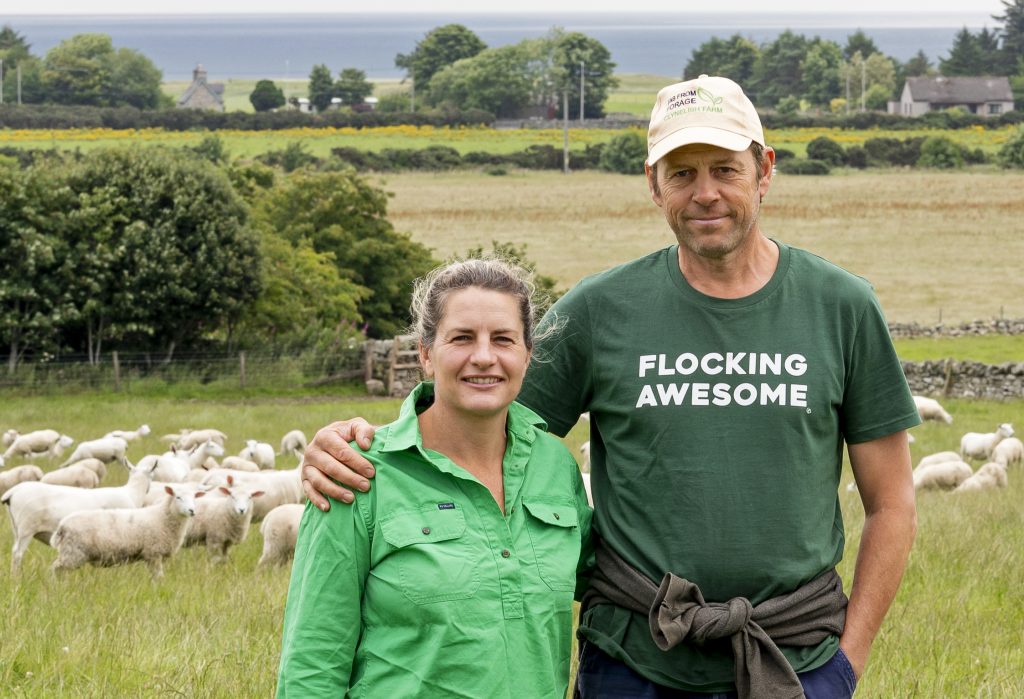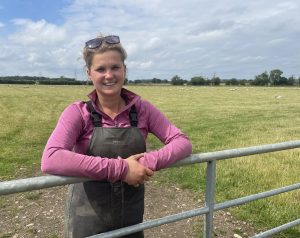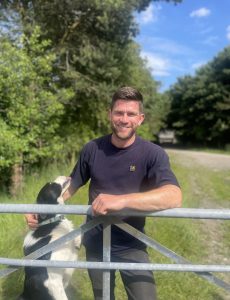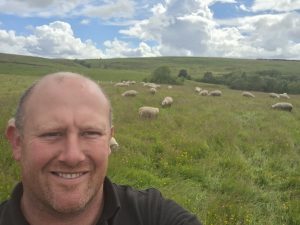with thanks to Jason and Vic Ballantyne, Clynelish, Brora, Sutherland.
Profitability together with work life balance are the two drivers for the Ballantyne’s no-frills approach to their farming business comprising a low input moderate output pure grass-based flock together with a complementary suckler herd based in one of mainland Britain’s furthest flung counties – Sutherland.
“This season our 700 ewe Aberfield cross flock, scanned 173% with 90% survival from scanning to tagging and minimum shepherding or intervention,” says Vic who together with Jason farms Clynelish, near Brora, a 125ha tenanted unit with additional rented grazing. The sheep are run alongside 90 suckler cows while Vic runs a B&B and self-catering in the summer.
The entire flock is lambed outdoors over 25 days commencing 20 April and outdoor calving starts the same day. “We set stock twins around 40 ewes/3ha paddocks and singles around 100/3ha. We drive around three times a day, though could probably reduce this as intervention is absolutely minimal. Aberfields are milky and make great mothers who stay with their lambs, so we’ve adopted a policy of leave well enough alone. We no longer number anything and haven’t had any problems with mismothering. A portion of the flock is bred to the Primera meat sire.
Lambs are often weaned at nine to 11 weeks, depending on grass availability, by when singles are averaging 32kg, and twins 28kg. The bulk are sold store either in the ring or privately at 15 weeks, though some of the heaviest and lightest lambs may be finished. Flexibility is key to the business, with decisions made annually to reflect weather and market conditions.
“Our mission is to produce high quality, high welfare, environmentally sustainable lamb and beef. We try to reduce financial risks so we’re able to cope with market volatility. It’s a case of pushing around the edges to see what we can do without,” she explains. “We stopped feeding concentrates in 2007.
Boluses and mineral buckets were also gradually phased out. This year, just 120 twin bearing ewes were supplemented with two silage bales and 5t swedes in the two weeks prior to lambing. Triplet carrying ewes are rotationally grazed after scanning in early February, while most of the remaining ewes are wintered away on good rough grazing.”
Vic says robustness and resilience are key to the flock’s overall success given the environmental and nutritional challenges of the north Highlands with a very long, dark and damp winter. These are the two values which led the Ballantynes to introduce the Aberfield to their mostly Cheviot cross flock in 2015. “Innovis genetics and their ethos just fitted what we were looking for – selection pressure, forage bred and reared and the ability to manage in a commercial low input environment. We want sheep that fit the environment rather than always trying to adapt the environment to the sheep. We have increased conception and improved survival with a ewe that does well on our ground in our system.
“We visited Southfield, home to Innovis’s 1,000 ewe nucleus flock located in the Borders at 1,000’ on a wet miserable day last November. We’ve always been convinced by the Innovis philosophy however it was good to see it in action. All the sheep were managed in commercial systems similar to our own, they’re certainly not pampered; we witnessed first-hand rams bred, reared and selected from systems that apply both environmental and nutritional pressure – something that is all too rare when it comes to ram breeding. That thorough selection process which includes performance figures, structure and temperament is very reassuring and why we continue to go to Innovis for our rams. We focus on EBVs that are high for maternal ability, fat, BCS and growth, though structure and ‘type’ are also important,” she says.
“Our Aberfield cross ewes are maturing at 65-70kg enabling us to maximise stocking rate and overall efficiency of our grazing system, they’re easier for me to handle and preferred over more extreme types. I don’t mind if they are a bit heavy if they are fat, but we don’t want tall, big framed, lean animals here.
“After July weaning, they have plenty of time to recover, and they’re used as a grazing management tool to tidy up behind the cows. The really impressive thing is they go into winter in good nick, and without anything more than good rough grazing, and they come out for lambing in tremendous condition and lamb with very few issues.
“The ewes have that ability to carry a bit of weight, retaining themselves in BCS 3-4 right throughout the year. We make sure there is no reason for them not to be fit and healthy and then it is their job to look after themselves. I’m more and more convinced that an animal’s ability to retain BCS is key to their health and fertility, which is why we have been able to reduce the use of other products. This also benefits our carbon footprint as we increase stocking density, lamb survival and longevity – ewes are averaging five lamb crops.”
Vic and Jason place a big focus on reducing worm burden and use of wormers by home FEC counts and strategic grazing – the cattle are essential, they follow the ewes, clean up the grazing and help reduce the worm burden. “Most ewes haven’t had a wormer for over two years, only ‘high risk’ animals are done prior to lambing. This year we got to weaning without worming the lambs and the FEC results were still showing very low counts.”
Seeking to add hybrid vigour again, the Ballantynes introduced the performance recorded Highlander damline to the flock in 2021. “We wanted to give the flock an extra boost, add some head wool and so far, so good. We ran the ewe lambs with the Hebridean and they’ve proven to be great mothers – they’re milky, look after their lambs well and are agreeable.”
“Profitability is number one at Clynelish, otherwise we couldn’t do any of the extra stuff that we take joy from, like planting new trees and hedges and time out for trips away,” says Vic.
Clynelish is a former AHDB QMS Sutherland Monitor Farm, a Farming For A Better Climate Focus
Farm and member of the QMS Grazing Group. Vic is a 2022 Nuffield Scholar which has taken her around the world in the last 12 months.
“We manage the farm’s day to day running ourselves though often have an Antipodean couple for a few months each summer to help with maintenance jobs and the B&B,” says Vic who was brought up on an 800ha mountain farm in New South Wales, left backpacking in 2006, arrived to Clynelish for lambing and the rest is history.
“Living relatively remotely, we enjoy visiting other farms and learning from others. We also are happy to host folk here and have them challenge our own ideas. There is nothing like a fresh set of eyes. We tend we try a few new ideas each year,” she says adding: “Then there’s the work life balance. Perfect down time is just sitting in the garden with a cider, and we both enjoy a weekend away to the rugby.”
To maximise grazing potential, the entire farm has been sub-divided with semi-permanent fencing in to 35, approximately 3ha paddocks with water to enable a leader-follower rotational grazing system. Post lambing, ewes with twins are mobbed up and stocked at 270 ewes per paddock and moved on every second day. Fifty cows and heifers follow on to tidy up. The singles are stocked similarly on the other side of the farm with the rest of the cows and heifers behind them.
“The rotation is naturally determined by grass growth; ideally, we take the covers from 2,500-3,000kg DM/ha down to 1,500kg DM/ha. While I occasionally plate meter, we have come to know when we need to move them and when we can start dropping paddocks out for silage. Everything is grazed to allow for an early turn out and it just means we make silage a bit later in the year.
We aim for a full rotation to take approximately three weeks, though the very dry May and June through up some challenges. We know the rest period is really important, but stock are always the priority. We’re careful not to hammer the grazing through the winter when we ship the flock off to local rented good hill grazing. It allows us to bring ewes home to really good quality pasture in early April. We have grown swedes and fodder beet in the past, but the opportunity to get the sheep away was too good to miss.”
She continues: “We rejuvenate the grazing paddocks regularly, usually with a herbal/rye grass/high clover mix. We’re still learning how to get the best results without putting a plough in the ground. Understanding how to get the most of out of these swards is also another learning curve. The ag community is terrific at sharing knowledge though and we have been very lucky to work with some very knowledgeable and clever farmers and researchers.
“Over the last few years we have used almost no fertiliser or herbicides, and have only direct drilled, including the swedes and fodder beet. It is always a bit of a risk, but it is a compromise we are willing to make. Alone they are all small steps, but when added together we feel we’re making good progress and keeping the bank balance in the black.”



